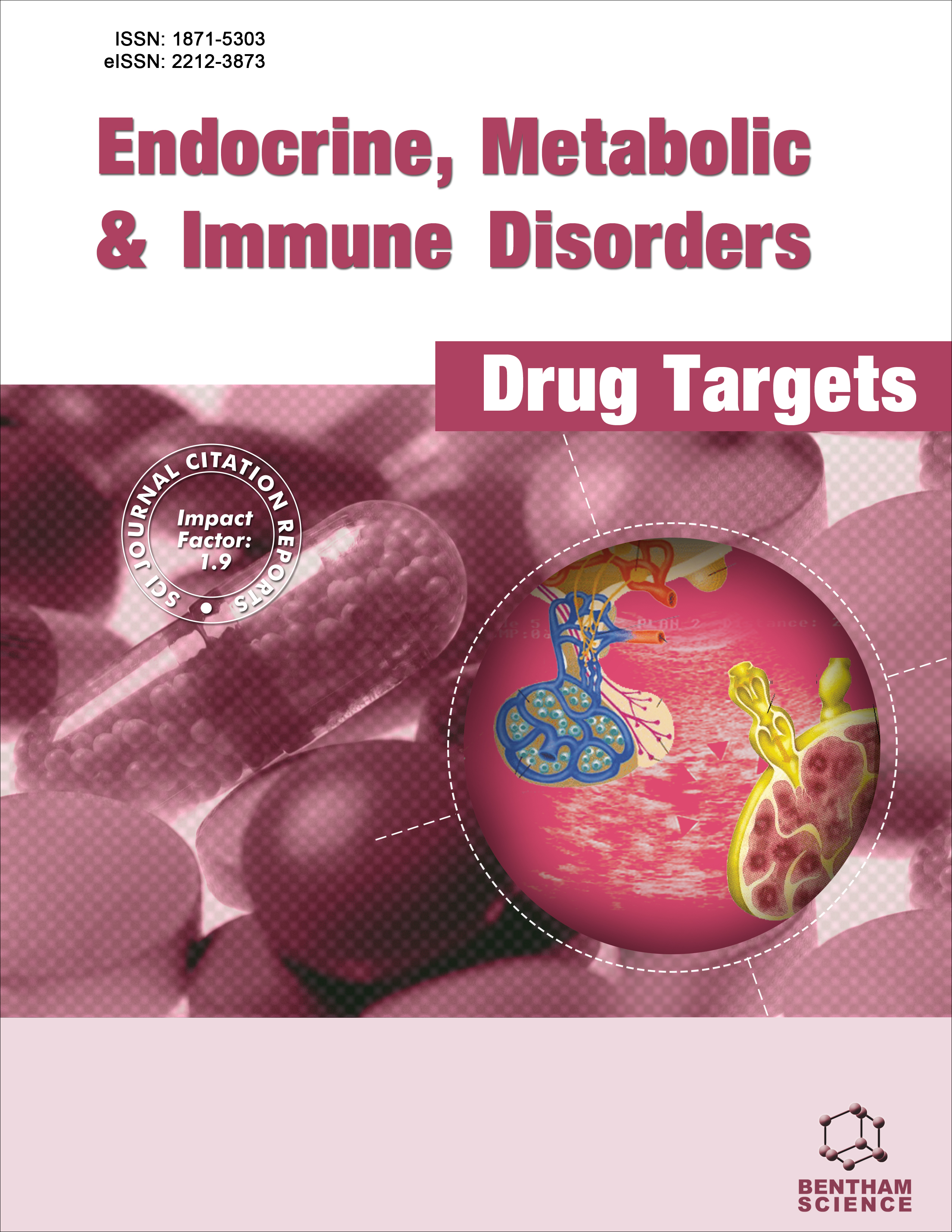- Home
- A-Z Publications
- Endocrine, Metabolic & Immune Disorders-Drug Targets (Formerly Current Drug Targets - Immune, Endocrine & Metabolic Disorders)
- Previous Issues
- Volume 10, Issue 2, 2010
Endocrine, Metabolic & Immune Disorders-Drug Targets (Formerly Current Drug Targets - Immune, Endocrine & Metabolic Disorders) - Volume 10, Issue 2, 2010
Volume 10, Issue 2, 2010
-
-
The Genetics of Obesity and the Metabolic Syndrome
More LessAuthors: Keri L. Monda, Kari E. North, Steven C. Hunt, D.C. Rao, Michael A. Province and Aldi T. KrajaIn this review, we discuss the genetic architecture of obesity and the metabolic syndrome, highlighting recent advances in identifying genetic variants and loci responsible for a portion of the variation in components of the metabolic syndrome, namely, adiposity traits, serum HDL and triglycerides, blood pressure, and glycemic traits. We focus particularly on recent progress from large-scale genome-wide association st Read More
-
-
-
Molecular Determinants of the Cardiometabolic Phenotype
More LessThe metabolic syndrome represents a clustering of risk factors that has been shown to predict adverse cardiovascular outcomes. Although the precise mechanisms contributing to the cardiometabolic syndrome (CMS) remain poorly defined, accumulating evidence identifies two intersecting candidate pathways responsible for inflammation and energy homeostasis in the pathophysiology that underlie cardiometabolic traits. Al Read More
-
-
-
Diet and Metabolic Syndrome
More LessAuthors: L. Djousse, H. Padilla, T.L. Nelson, J.M. Gaziano and K.J. MukamalGiven the higher burden of risk factors for metabolic syndrome (MetS) on morbidity and mortality, it is critical to prevent the development of metabolic syndrome in the first place. While dietary habits have been favorably associated with some of the factors included in the definition of metabolic syndrome, limited and inconsistent data have been reported on the role of nutrition in the development of metabolic syndrom Read More
-
-
-
Fenofibrate and Metabolic Syndrome
More LessThe fibric acid derivative, fenofibrate (FF) has been used in the US since 1998 to manage patients with dyslipidemia. Typical changes in serum lipids as a result of FF treatment include clinically important mean reductions of serum triglycerides (TG) by a mean change of -93.7 mg/dL (-39.3%), increases of high density lipoprotein cholesterol (HDLC) by +5.5 mg/dL (+12.4%), and reductions in low density lipoprotein cholesterol (L Read More
-
-
-
A Broad Variety of Antigens Contribute to the Pathogenesis of Atherosclerosis: How to Neutralize Noxious Reactions in the Host
More LessAuthors: T. Magrone and E. JirilloAtherosclerosis is an inflammatory disease characterized by lipid accumulation as well as vascular injury due to a massive infiltration of immune cells in the endothelial wall. Microbial and self- antigens are responsible for a persistent activation of immune and non-immune cells, thus leading to a condition of arterial chronic inflammation with plaque formation and rupture in complicated cases. In particular, the effects of bacteri Read More
-
-
-
Interferon-beta Inhibits Th17 Cell Differentiation in Patients with Multiple Sclerosis
More LessAuthors: Vinod S. Ramgolam and Silva Markovic-PleseInterferon-beta (IFNβ) has been used over the past 15 years as a first-line therapy for relapsing remitting multiple sclerosis (RR MS), however its mechanisms of action are still not completely elucidated. Recently discovered Th17 cells have been hypothesized to play a crucial role in the development of autoimmune diseases, including MS. Studies from our laboratory and others have demonstrated that IFNβ treatment su Read More
-
-
-
WNT4 Signaling in Female Gonadal Development
More LessAuthors: Miriam Pellegrino, Raffaella Maiorino and Sergio SchonauerWNT4 signaling pathways represent an important step in the multi-faceted process of mammalian gonadal differentiation and the development of internal genitalia. WNT4 protein controls the cytoplasmatic stability of specific transcriptional coactivator β catenin during both embriogenesis and adult homeostasis. The biological significance of WNT4 consists in determining the final female reproductive system, inhibiting Wolff duc Read More
-
-
-
Bowel Habit in Preterm New borns: Effect of New Formulas
More LessPreterm infants may pass meconium only after the first 48 hours of life, even in the absence of any gastrointestinal disease. The role of various factors in determining the time of meconium elimination has been recently assessed. Gestational age and start of feeding had been demonstrated to influence first meconium timing. The aim of our study was to evaluate the time of first meconium passage and the time to achieve re Read More
-
-
-
How Close are We in Achieving Safe, Affordable and Reversible Male Contraceptives?
More LessAuthors: Daulat R.P. Tulsiani and Aida Abou-HailaThe world population, currently estimated to be over six billions, is expected to double in the next forty years. The projected growth will cause severe over crowding that will have an adverse effect on the ecological health of the planet. A recent survey by the United Nations found that a majority of men in many countries are willing to participate in family planning by taking full control of their fertility. However, the availabl Read More
-
Volumes & issues
-
Volume 25 (2025)
-
Volume 24 (2024)
-
Volume 23 (2023)
-
Volume 22 (2022)
-
Volume 21 (2021)
-
Volume 20 (2020)
-
Volume 19 (2019)
-
Volume 18 (2018)
-
Volume 17 (2017)
-
Volume 16 (2016)
-
Volume 15 (2015)
-
Volume 14 (2014)
-
Volume 13 (2013)
-
Volume 12 (2012)
-
Volume 11 (2011)
-
Volume 10 (2010)
-
Volume 9 (2009)
-
Volume 8 (2008)
-
Volume 7 (2007)
-
Volume 6 (2006)
Most Read This Month
Article
content/journals/emiddt
Journal
10
5
false
en


